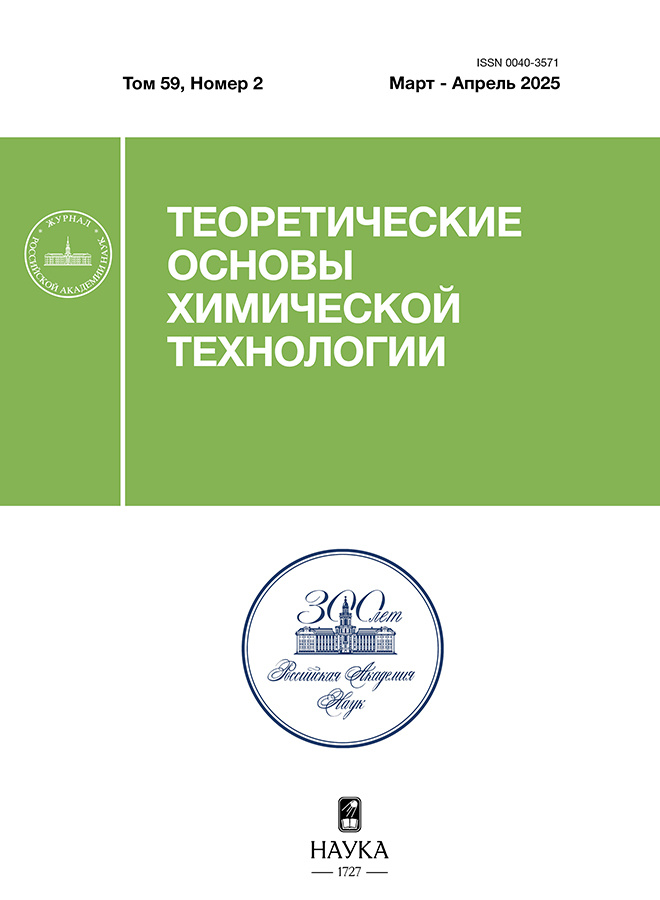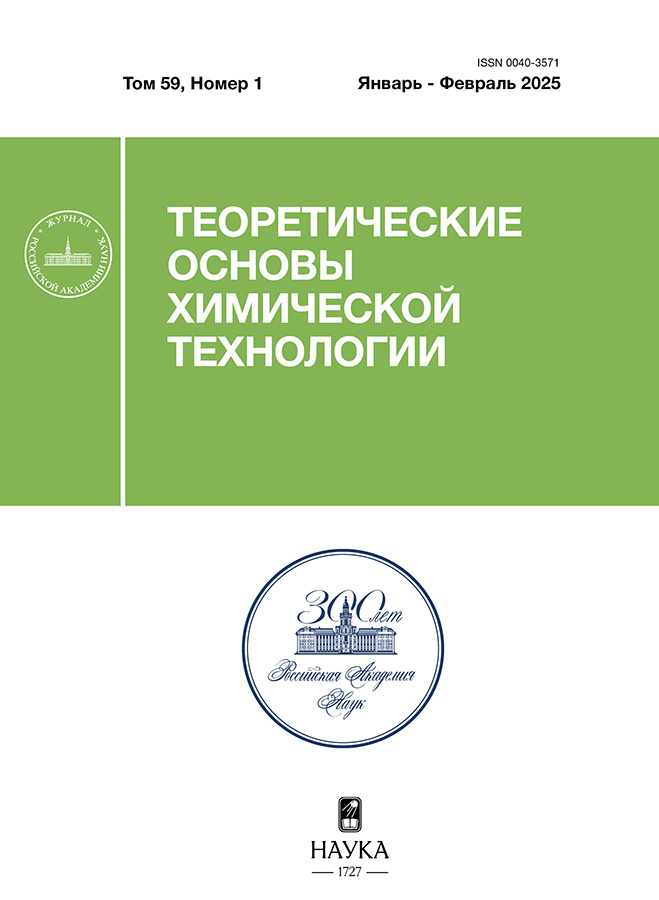Modeling of the processing of alkanthiols into disulfides using ionic liquids
- Authors: Shinkar E.V.1, Tishkov A.A.1, Okhlobystin A.O.2, Berberova N.T.1
-
Affiliations:
- Astrakhan State Technical University
- Gazprom Pererabotka LLC
- Issue: Vol 59, No 1 (2025)
- Pages: 23–33
- Section: Articles
- Published: 02.07.2025
- URL: https://ruspoj.com/0040-3571/article/view/686505
- DOI: https://doi.org/10.31857/S0040357125010037
- EDN: https://elibrary.ru/tydnjg
- ID: 686505
Cite item
Abstract
A functional model of environmentally safe and energy-saving technology for removal of toxic alcanthiols for their processing into practically useful disulfides using ionic liquids is proposed. The process is based on mediator electrooxidation of alcanthiols removed from liquid fuels by extraction with ionic liquids. The developed method of indirect electrosynthesis of symmetrical disulfides is realized under mild conditions, in the environment of electrically conductive ionic liquids, acting as a solvent and background electrolyte. The use of mediator contributes to the increase of electrosynthesis efficiency and reduction of energy consumption for its realization in comparison with the direct electrochemical oxidative transformation of alcanthiols into disulfides.
Full Text
About the authors
E. V. Shinkar
Astrakhan State Technical University
Author for correspondence.
Email: elenshin@rambler.ru
Russian Federation, Astrakhan
A. A. Tishkov
Astrakhan State Technical University
Email: elenshin@rambler.ru
Russian Federation, Astrakhan
A. O. Okhlobystin
Gazprom Pererabotka LLC
Email: elenshin@rambler.ru
Russian Federation, Novy Urengoy
N. T. Berberova
Astrakhan State Technical University
Email: elenshin@rambler.ru
Russian Federation, Astrakhan
References
- Harlan W. Nelson, Carl J. Lyons. Sources and control of sulfur-bearing pollutants // J. Air Pollut. Control Assoc. 2012. V. 7. № 3. P. 187. https://doi.org/10.1080/00966665.1957.10467800
- Perraud V., Horne J.R., Martinez A.S., Kalinowski J., Meinardi S., Dawson M.L., Wingen Lisa M., Dabdub D., Blake D.R., Gerber R.B., Finlayson-Pitts B.J. The future of airborne sulfur-containing particles in the absence of fossil fuel sulfur dioxide emissions // PNAS. 2015. V. 112. № 44. P. 13519. https://doi.org/10.1073/pnas.1510743112
- Tanimu A., Alhooshani K. Advanced Hydrodesulfurization Catalysts: A Review of Design and Synthesis // Energy Fuels. 2019. V. 33. № 4. P. 2810. https://doi.org/10.1021/acs.energyfuels.9b00354.
- Dehkordi A.M., Sobati M.A., Nazem M.A. Oxidative Desulfurization of Non-hydrotreated Kerosene Using Hydrogen Peroxide and Acetic Acid // Chin. J. Chem. Eng. 2009. V. 17. № 5. P. 869. https://doi.org/10.1016/S1004-9541(08)60289-X
- Moghadam F. R., Kianpour E., Azizian S., Meysam Y., Zolfigo M. A. Extractive desulfurization of liquid fuel using diamineterminated polyethylene glycol as a very low vapour pressure and green molecular solvent // Soc. Open Sci. 7: 200803. https://doi.org/10.1098/rsos.200803
- Gao J., Zhu S., Dai Y., Xiong C., Li C., Yang W., Jiang X. Performance and mechanism for extractive desulfurization of fuel oil using modified polyethylene glycol // Fuel. 2018. V. 233. P. 704. https://doi.org/10.1016/j.fuel.2018.06.101
- Meng X., Zhou P. Li L., Liu L., Guo M., Sun T. A study of the desulfurization selectivity of a reductive and extractive desulfurization process with sodium borohydride in polyethylene glycol // Scientific Reports. 2020. V. 10. P. 10450 https://doi.org/10.1038/s41598-020-67235-8
- Abro R., Abdeltawab A.A., Al-Deyab S.S., Yu G., Qazi A.B., Gao S., Chen X. A review of extractive desulfurization of fuel oils using ionic liquids // RSC Advances. 2014. V. 4. № 67. P. 35302. https://doi.org/10.1039/C4RA03478C
- Francisco M., Arce A., Soto A. Ionic liquids on desulfurization of fuel oils // Fluid Phase Equilibria. 2010. V. 294. № 1-2. P. 39. https://doi.org/10.1016/j.fluid.2009.12.020
- Ferreira A.R., Neves L.A., Ribeiro J. C., Lopes F.M., Coutinho J.A.P., Coelhoso I. M., Crespo J.G. Removal of thiols from model jet-fuel streams assisted by ionic liquid membrane extraction // Chem. Eng. J. 2014. V. 256. № 15. P. 144. https://doi.org/10.1016/j.cej.2014.06.107
- Yu F., Liu C., Yuan B., Xie P. Energy-efficient extractive desulfurization of gasoline by polyether-based ionic liquids // Fuel. 2016. V. 177. P. 39. https://doi.org/10.1016/j.fuel.2016.02.063
- Gao J., Meng H., Lu Y., Zhang H., Li C. A carbonium pseudo ionic liquid with excellent extractive desulfurization performance // AlChE J. 2013. V. 59. P. 948. https://doi.org/10.1002/aic.13869
- Eco-Friendly Energy Processes and Technologies for Achieving Sustainable Development/ Danish M. S. S., Senjyu T. S., Publisher: IGI Global, 2020. https://doi.org/10.4018/978-1-7998-4915-5
- Meshalkin V.P., Kulov N.N., Guseva T.V., Tikhonova I.O., Burvikova Yu.N., Bhimani Ch., Shchelchkov K.A. Best Available Techniques and Green Chemical Technology: Possibilities for Convergence of Concepts // Theor. Found. Chem. Eng. 2022. V. 56. № 6. P. 670. [Мешалкин В.П., Кулов Н.Н., Гусева Т.В., Тихонова И.О., Бурвикова Ю.Н., Бхимани Ч., Щелчков К.А. Наилучшие доступные технологии и зеленая химическая технология: возможности сближения концепций // Теорет. основы хим. технологии. 2022. Т. 56. № 6. C. 670.] https://doi.org/10.31857/S0040357122060124
- Leech M.C., Garcia A.D., Petti A.A., Dobbs P., Lam K. Organic electrosynthesis from academia to industry // React. Chem. Eng. 2020. V. 5. № 6. P. 977.
- Francke R., Little R.D., Inagi S. Organic Electrosynthesis // ChemElectroChem 2019. № 6. Р. 4065. https://doi.org/10.1002/celc.201901175
- Cardoso D.S.P., Šljukić B., Santos D.M.F., Sequeira C.A.C. Organic Electrosynthesis: From Laboratorial Practice to Industrial Applications //Org. Process Res. Dev. 2017. V. 21. № 9. P. 1213. https://doi.org/10.1021/acs.oprd.7b00004
- Moiseev I. Green chemistry: development jectory // Russ. Chem. Rev. 2013. V. 82. № 7. P. 616. https://doi.org/10.1070/RC2013v082n07ABEH004393.
- Fron-tana-Uribe B.A., Little R.D., Ibanez J.G., Palma A., Vasquez-Medrano R. Organic electrosynthesis: a promising green methodology in organic chemistry // Green Chem. 2010. V. 12. № 12. P. 2099. https://doi.org/10.1039/C0GC00382D.
- Ratti R. Ionic Liquids: Synthesis and Applications in Catalysis // Adv. in Chem. 2014. ID 729842. https://doi.org/10.1155/2014/729842
- Earle M.J., Seddon K.R. Ionic liquids. Green solvents for the future // Pure and Appl. Chem. 2000. V. 72. № 7. P. 1391. https://doi.org/10.1351/pac200072071391
- Kathiresan M., Velayutham D. Ionic liquids as an electrolyte for the electrosynthesis of organic compounds // Chem. Com. 2015. V. 99. № 51. P. 17499. https://doi.org/10.1039/C5CC06961K
- Bornemann S., Handy S.T. Synthetic Organic Electrochemistry in Ionic Liquids: The Viscosity Question // Molecules. 2011. V. 16. P. 5963. https://doi.org/10.3390/molecules16075963
- Mandal B., Basu B. Recent advances in S–S bond formation // RSC Adv. 2014. V. 4. № 27. P. 13854. https://doi.org/10.1039/C3RA45997G
- Huang P., Wang P., Tang S., Fu Z., Lei A. Electro-oxidative S−H/S−H cross-coupling with hydrogen evolution: facile access to unsymmetrical disulfides // Angewandte. 2018. V. 57. № 27. P. 8115. https://doi.org/10.1002/anie.201803464
- Trost B.M. On inventing reactions for atom economy // Acc. Chem. Res. 2002. V. 35. №. 9. P. 695. https://doi.org/10.1021/ar010068z
- Novaes L.F.T., Liu J., Shen Y., Lu L., Meinhardt J.M., Lin S. Electrocatalysis as an enabling technology for organic synthesis // Chem. Soc. Rev. 2021. V. 50. № 14. P. 7941. https://doi.org/10.1039/d1cs00223f
- Kitada S., Takahashi M., Yamaguchi Y., Okada Y., Chiba K. Soluble-support-assisted electrochemical reactions: application to anodic disulfide bond formation // Org. Let. 2012. V. 23. № 14. P. 5960. https://doi.org/10.1021/ol302863r
- Zhang G., Etzold B. Ionic liquids in electrocatalysis // JEnergyChem. 2016, V. 25. № 2. P. 199. https://doi.org/10.1016/j.jechem.2016.01.007
- Wang X.-F., Zhang S., Li B.-L., Zhao J.-J., Liu Y.-M., Zhang R.-L., Li B., Chen B.-Q. Synthesis and biological evaluation of disulfides bearing 1,2,4-triazole moiety as antiproliferative agents // Med. Chem. Res. 2017. V. 26. P. 3367. https://doi.org/10.1007/s00044-017-2029-0
- Feng M., Tang B., Liang S.H., Jiang X. Sulfur containing scaffolds in drugs: synthesis and application in medicinal chemistry // Curr. Top. Med. Chem. 2016. V. 16. № 11. P. 1200. https://doi.org/10.2174/1568026615666150915111741
- Wang W., Lin Y., Ma Y., Tung C.-H., Xu Z. Cu-catalyzed electrophilic disulfur transfer: synthesis of unsymmetrical disulfides // Org. Lett. 2018. V. 20. № 13. P. 3829. https://doi.org/10.1021/acs.orglett.8b01418
- Kuramochi K., Sunoki T., Tsubaki K., Mizushina Y., Sakaguchi K., Sugawara F., Ikekita M., Kobayashi S. Transformation of thiols to disulfides by epolactaene and its derivatives // Bioorg. Med. Chem. 2011. V. 19. № 14. P. 4162. https://doi.org/10.1016/j.bmc.2011.06.015
- Natarajan P., Sharma H., Kaur M., Sharma P. Haloacid/dimethyl sulfoxide-catalyzed synthesis of symmetrical disulfides by oxidation of thiols // Tetrahedron Lett. 2015. V. 56. № 41. P. 5578. https://doi.org/10.1016/j.tetlet.2015.08.041
- Leino R., Lonnqvist J.-E. A very simple method for the preparation of symmetrical disulfides. Tetr. Let. 2004. V. 45. № 46. P. 8489. https://doi.org/10.1016/j.tetlet.2004.09.100
- Berberova N.T., Shinkar E.V., Smolyaninov I.V., Pashchenko K.P. Redox-mediators of hydrogen sulfide oxidation in reactions with cycloalkanes // Doklady Chem. 2015. V. 465. № 2. P. 295. [Берберова Н.Т., Шинкарь Е.В., Смолянинов И.В., Пащенко К.П. Редокс-медиаторы окисления сероводорода в реакциях с циклоалканами // Докл. АН. 2015. Т. 465. № 2. С. 295.] https://doi.org/10.1134/S0012500815120058
- Berberova N.T., Shinkar E.V., Smolyaninov I.V., Shvetsova A.V., Sediki D.B. Electrosynthesis of biologically active dicycloalkyl di– and trisulfides involving an H2S–S8 redox system // Russ. Chem. Bull. 2018. V. 67. № 1. P. 108. [Берберова Н.Т., Шинкарь Е.В., Смолянинов И.В., Швецова А.В., Седики Д.Б. Электросинтез биологически активных дициклоалкил ди– и трисульфидов с участием редокс-системы H2S-S8 // Изв. АН. Сер. хим. 2018. Т. 67. № 1. С. 108.] https://doi.org/10.1007/s11172-018-2044-4
- Bogomolov B.B., Boldyrev V.S., Zubarev A.M., Meshalkin V.P., Men’shikov V.V. Intelligent Logical Information Algorithm for Choosing Energy – and Resource-Efficient Chemical Technologies // Theor. Found. Chem. Eng. 2019. V. 53. № 5. P. 483. [Богомолов Б.Б., Болдырев В.С., Зубарев А.М., Мешалкин В.П., Меньшиков В.В. Интеллектуальный логико-информационный алгоритм выбора энергоресурсоэффективной химической технологии // Теорет. основы хим. технологии. 2019. Т. 53. № 5. С. 483.] https://doi.org/10.1134/S0040357119050026
- Bogomolov B.B., Bykov E.D., Men’shikov V.V., Zubarev A.M. Organizational and technological modeling of chemical process systems // Theoret. Found. Chem. Eng. 2017. V. 51. № 2. P. 238. [Богомолов Б.Б., Быков Е.Д., Меньшиков В.В., Зубарев А.М. Организационно-технологическое моделирование химико-технологических систем // Теорет. основы хим. технологии. 2017. Т. 51. № 2. С. 238.] https://doi.org/10.1134/S0040579517010043
- Meshalkin V., Shinkar E., Berberova N., Pivovarova N., Ismagilov F., Okhlobystin A. Logical-information model of energy-saving production of organic sulfur compounds from low-molecular sulfur waste fuel oil // Energies. 2020. V. 13. e 5286. https://doi.org/10.3390/en13205286
- Гордон А., Форд Р. Спутник химика. М: Мир, 1976. [A.J. Gordon, R.A. Ford, The chemist’s companion, A Wiley interscience publication, New York, 1972.].
- Байзер М.М., Лунд Х. Органическая электрохимия, М: Химия, 1988. [M.M. Baizer, H. Lund, Organic electrochemistry, New York; Marcel Dekker, 1983].
- Okhlobystina A.V., Okhlobystin A.O., Letichevskaya N.N., Abdulaeva V.F., Berberova N.T., Movchan N.O. Electrochemical synthesis of aromatic sulfur compounds in ionic liquids // Russ. J. Gen. Chem. 2016. V. 86. № 2. P. 291. [Охлобыстина А.В., Охлобыстин А.О., Летичевская Н.Н., Абдулаева В.Ф., Берберова Н.Т., Мовчан Н.О. Электрохимический синтез ароматических соединений серы в среде ионных жидкостей // ЖОХ. 2016. Т. 86. № 2. С. 291.] https://doi.org/10.1134/S1070363216020146
- Yu Y.-H., Soriano A., Li M.-H. Heat capacities and electrical conductivities of 1-n-butyl-3-methylimidazolium-based ionic liquids // Thermochimica Acta. 2009. V. 482, № 1–2. P. 42. https://doi.org/10.1016/j.tca.2008.10.015
- Plechkova N.V., Seddon K.R. Ionic liquids further UnCOILed: critical expert overviews / N.V. Plechkova, K.R. Seddon, John Wiley & Sons, Inc., 2014.
- Safarov J., Kul I., El-Awady W.A., Nocke J., Shahverdiyev A., Hassel E. Thermophysical properties of 1-butyl-4-methylpyridinium tetrafluoroborate // J. Chem. Thermodynamics. 2012. V. 51. P. 82. https://doi.org/10.1016/j.jct.2012.02.018
- Singh T., Kumar A. Static dielectric constant of room temperature ionic liquids: internal pressure and cohesive energy density approach // J. Phys. Chem. B. 2008. V. 112. № 41. P. 12968. https://doi.org/10.1021/jp8059618
- Helambe, S.N., Lokhande M.P., Kumbharkhane A.C., Mehrotra S.C., Doraiswamy S. Dielectric study of aqueous solution of acetonitrile // Pramana – J Phys. 1995. V. 44. P. 405. https://doi.org/10.1007/BF02848492
- Vila J., Varela L.M., Cabeza O. Cation and anion sizes influence in the temperature dependence of the electrical conductivity in nine imidazolium based ionic liquids // Electrochimica Acta. 2007. V. 52. № 26. P. 7413.
- https://doi.org/10.1016/j.electacta.2007.06.044
- Okhlobystina A.V., Okhlobystin A.O., Letichevskaya N.N., Abdulaeva V.F., Berberova N.T., Movchan N.O. An alternative method for the desulfurization of hydrocarbon fuels // Mendeleev Commun. 2017. V. 27. № 1. P. 104.
Supplementary files



















